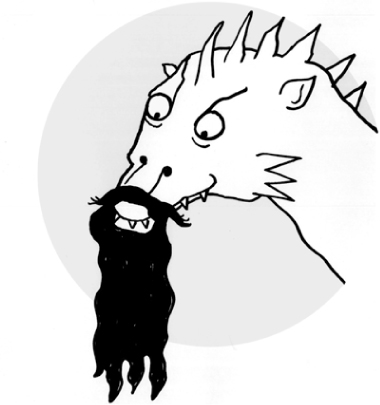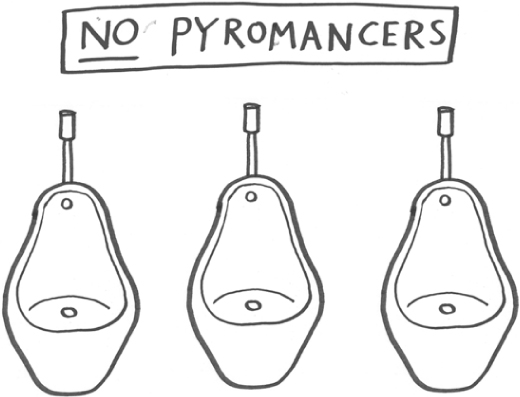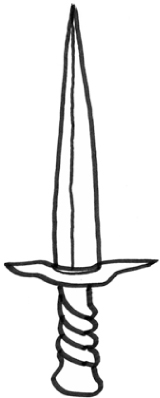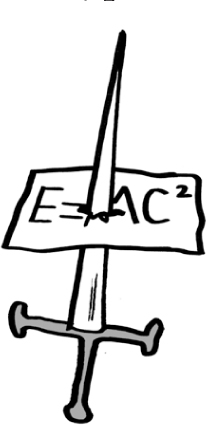CHAPTER 2
FIRE POWER

 Wildfire
Wildfire 
In the climactic Battle of the Blackwater, the mighty forces of Stannis Baratheon are ranged against the beleaguered capital, King’s Landing. Tyrion Lannister, occupying the unenviable position as the Hand of King Joffrey Baratheon (best not to think about where Joffrey’s actual hands have been) sends a single ship to meet the invading fleet. That ship is laden with wildfire and, ignited by a single arrow from the bow of Tyrion’s friend the sellsword Bronn, it swiftly engulfs the closely packed enemy galleys in flames.
Wildfire is a creatively unpleasant addition to vicious Westerosi wars as it burns everything before it and spreads like, well, wildfire. After the death of the last dragon, wildfire was developed at the behest of the Targaryen dynasty as a substitute for dragonfire. The manufacture of the substance is a secret closely guarded by the Alchemists’ Guild. It is apparently known in less enlightened parts of the kingdom as ‘pyromancer’s piss’. (N.B. If your pee is capable of burning men alive/setting ships ablaze, please put this book down and seek urgent medical attention.)

Human beings being what they are, it’s no surprise to discover that, in our world, science has created a weapon that is a match for wildfire’s sinister flames. In the 1940s a team led by organic chemist Louis Fieser and based at Harvard University found that adding a thickening agent to fuel created something that burned longer and also tended to stick to surfaces. Napalm (named after two of the constituents of its thickening agent, naphthenic acid and palmitic acid) is a burning gel, usually based on petroleum, that sticks to roofs, furniture and skin. Being oil-based it will burn on, and not be easily extinguished by, water–just like our Westerosi wildfire. Napalm’s horrific role in the Vietnam war is notorious, and the UN finally outlawed its use against civilians in 1980.
But during World War II there was a plan to deploy napalm that could’ve come straight out of the imagination of George RR Martin himself. The US military plotted to arm bats with napalm. Really. Killer napalm bats! This plan was known as Project X-Ray (as, presumably, Project BatShit didn’t quite strike the right note). Professor Fieser was asked to create tiny incendiary devices that the bats could carry into enemy territory. He came up with oblong, nitrocellulose cases filled with thickened kerosene with a small time-delay igniter cemented along one side. This curious (to say the least) scheme originated in the mind of a 60-something Pennsylvanian dentist, Lytle S Adams, who wrote to President Roosevelt vividly setting out how ‘the millions of bats that have for ages inhabited our belfries, tunnels and caverns were placed there by God to await this hour to play their part in the scheme of free human existence, and to frustrate any attempt of those who dare to desecrate our way of life…’ The president was quick to get on board with Adams’s idea of bats as divine defenders of the free world, emphasising to the military, re the crusading dentist, ‘this guy is not a nut’. Mmm!
In our world, as in Westeros, this highly potent fire isn’t too fussy about what it burns, and during a test flight the bomber bats accidentally set a US military base ablaze. In the event, the deployment of their fatal flames during World War II was prevented by the speedier development of an even deadlier device, the Atomic Bomb. Perhaps in comparison to that ultimate weapon, the wars and tactics in King’s Landing aren’t quite so terrifying after all.

 Temper, Temper–The Mysterious
Temper, Temper–The Mysterious 
Science of Getting Your Sword Just Right
We have all been there. One minute you are making amazing steel weapons that can slice through armour, hold an edge forever and wreak havoc on the world, the next, you forget how to produce the stuff and that’s the end of that.
It was exactly the same in Essos. For over 5,000 years a small group of highly skilled wizards used Westerosi magic to craft Valyrian steel into swords and daggers. The pinnacle of expertly-crafted weaponry, these fine blades were forged in dragon’s fire and developed a fearsome reputation for being unbelievably strong, sharp and able to withstand the most extreme of temperatures. Oily black and covered in thousands of intricate and elaborate swirls, they quickly became the weapon of choice for serious-minded dragon warriors across the Seven Kingdoms. Then along came the Doom of Valyria, the wizards lost their magical touch, and suddenly aforementioned dragon warriors were forced to–I don’t know–wrap tinfoil around a sharpened stick? Embarrassing.
I became intrigued by the secrets of sword-making–and in particular, the process of hardening and tempering the blade of a sword–after coming across the story of world saviour Azor Ahai and his flaming sword, Lightbringer. Westeros legend tells that to fight the forces of Winter and the White Walkers, and win the Battle for the Dawn, Azor Ahai was tasked with forging a sword like no other. But after numerous attempts to do this–tempering according to the more regular rules of Bladesmithing for Dummies–he only produced swords that broke. In the end, he fixed his blade by plunging it into the heart of the thing he loved most of all, his wife Nissa Nissa. She died (Boo!) but the world survived (Hurrah!). Emotional reactions may have been more complex at the time, particularly Nissa Nissa’s, but let’s press on. We’ve a sword to get right.

Now the Seven Kingdoms is in need of another hero. Melisandre proclaims that the ‘Prince that was Promised’, aka Azor Ahai reborn, is Stannis Baratheon. She gives Stannis a ‘magic’ sword that flames like the fabled Lightbringer, but she is not able to get the sword to radiate heat. It’s all just one of her tricks rather than real magic. (This may have given Shireen false hope. Ach! Melisandre! Why did you have to burn the screaming, sweet, bookish kid with the skin condition?)
The idea of quenching a sword in human blood sounds fantastical, but George RR Martin was undoubtedly inspired by the gory mythology surrounding the creation of Damascus steel, used during the crusades in Europe across the 11th century. The formula for making Damascus steel remained a closely guarded secret with armourers in the Middle Ages. But according to writings found in Asia Minor, wonderfully superior swords may have been tempered in the blood of slaves. In one ancient account, a worthy blade needed to be heated until it glowed ‘like the sun rising in the desert’ before being plunged ‘into the body of a muscular slave’ so that his strength would be transferred to the sword.
Even in our modern era, past myths about the process of making great steel are invoked. ‘Arabs Tempered Steel By Plunging Into Slaves, New Method Is Better’ a mid-20th century headline trumpeting a newly developed cooling oil declared.
One of the neat things about ancient heat treatment is that they had no timers or thermometers, or understanding of the processes, so a lot of it involved experience, closely held trade secrets and a good share of superstition–which may be where the stories of unfortunate slaves came from. (Let’s hope!)
 The Secrets of Valyrian Steel
The Secrets of Valyrian Steel 
Game of Thrones gets swords. Unlike some fantasy history epics we shan’t name, the show generally offers a realistic portrayal of both the weapons themselves and how they’re used for fighting. Experts tend to agree on this. For starters, a guy who is a professional blade-smith says so on YouTube (and he has plaited his beard like a badass Illyrian so I believe him). I double checked, of course.
In a quest to uncover the long-lost secret of Valyrian steel, Ryan Consell spent years immersing himself in the lore of Essos. He began his investigation by examining the properties of ordinary steel, which is made by mixing a large amount of iron with a small amount of carbon. The good news is that the resulting alloy is extremely hard and, as anyone who has tried to make a dagger out of Jell-O will tell you, the harder the material, easier the it is to sharpen. There is, however, one major problem. The harder the material, the more easily it shatters; Consell quickly discovered that an ordinary steel sword would run the risk of shattering on an enemy’s shield.
Consell then turned his attention to spring steel, which is made by mixing iron with a tiny amount of carbon, and then adding silicon and manganese. Unlike ordinary steel, spring steel can both hold a sharp edge and be remarkably strong. Consell thought that he was onto a winner until he realised that whereas Valyrian steel performs well at extremely high temperatures, sprung steel would simply melt away when faced with even the tiniest of coughs from a fire-breathing dragon.
Undeterred, and ever the scientist he moved onto his third candidate: air-hardened steel. The good news is that air-hardened steel isn’t fussy–it doesn’t need careful heat treatment, just to cool off in the open air. The bad news is that, although it can be polished to a dark grey, it can’t have the oily blackness or elaborate swirls commonly associated with Valyrian steel.
Just when he was about to abort his quest, Consell had a brainwave. Maybe, he thought, Valyrian steel isn’t steel at all but rather a ‘metal matrix composite’. These amazing modern-day super materials are created by embedding ceramic compounds into the structure of a metal. Whilst analysing the properties of various composites, Consell came across a remarkable material called titanium-silicon carbide (or, as researchers sometimes refer to it, TSC). Any blade created from TSC would be amazingly sharp, strong and capable of performing well in even the highest of temperatures. Not only that, but TSC’s remarkable structure means that the blade could be made to look jet black and even have Valyrian steel-esque swirls of grey running through it says Consell. ‘Combining the properties of different elements in tightly controlled ways which could make something that would seem borderline magical to a medieval society.’
After years of trial and error, has Ryan Consell finally uncovered the secret of Valyrian steel? Alas, we don’t know for sure, but the signs are good. He was last seen heading towards the master-blacksmiths of Qohor, clutching a titanium-silicon carbide blade in one hand and a patent application in the other…
 Waiting for a Star to Fall
Waiting for a Star to Fall 
So I Can Make it Into a Sword (While Listening to Megadeth)
Not all the swords on Game of Thrones are forged from Valyrian steel. One of the most exciting-sounding swords in this world belongs to a character we only see in flashbacks e.g in Season 6, Ser Arthur Dayne, aka the Sword of the Morning. (This is the title associated with his House that only one who has proved himself worthy may bear, and you should definitely not be giggling at this talk of ‘morning swords’ because we’re all serious scientifically minded adults here.)
Ser Arthur is a great and famed knight, a Kingsguard who was killed in a fight by noble Ned who has come to find his sister Lyanna Stark at the Tower of Joy. Ser Arthur was said to be the greatest swordsman in the Seven Kingdoms. But not for him the spell-forged Valyrian steel. No! His ancestral sword is crafted from even rarer stuff–it’s made from a fallen star. Or, to be more prosaic, a meteorite. The name of the sword is Dawn, and its home is House Dayne’s seat in Dorne, at a place called Starfall. This hints at the origin of the sword; how it came to be in the family. Dawn is described in the books rather magically–unsheathed it glows beautifully moon-pale, alive with light.
So, of course, I have to know: are meteor swords a real thing? Do we have them in our world? Well, if you’re a regular reader of fantasy literature you’ll suspect the answer is a resounding Yes! They even jab through into real life. When the much-loved, much-missed fantasy writer Terry Pratchett became Sir Terry Pratchett he gave a lot of thought to his sword (because knights must have swords, right?). Ser Terry decided his would include a little ‘thunderbolt iron’, as the meteor-metal is sometimes known. ‘Most of my life I’ve been producing stuff which is intangible and so it’s amazing the achievement you feel when you have made something which is really real,’ he said of the sword, which he smelted himself. So what is the origin this well-travelled metal? Some of it is from nearby rocks floating around our solar system, some from regions of space far beyond, the molten core of long-gone planets. But it ends up all over our world.
If we travel back in history, we find that from the dawn of ancient times, the world fancied the idea of making things from meteorites. A ‘very heavy’ statue of a Buddha-like figure, which was stolen by the Nazis from Tibet, comes from an ataxite meteorite–a combination of space rock that is mainly iron mixed with a smaller quantity of nickel. Now known as the Iron Space Man, it was probably carved a thousand years ago, but a chemical analysis reveals it most likely fell to Earth on what’s known as the Chinga meteorite field in Mongolia between 10 and 20 millennia ago.
To the Ancient Egyptians, meteorites were ‘sky metal’–a precious gift from the heavens. They lacked the technology to smelt iron–which due to iron’s high melting point of 1,538°C requires very hot furnaces to get it out of the ore–but highly skilled metal workers made beautiful objects from the iron they found. When King Tutankhamun’s tomb was opened, he was discovered in possession of a dagger made from meteorite iron. And some iron beads that had rusted, and become dull and ordinary over time, but would have had a stunning rainbow lustre when new. The king’s necklace was crafted from space-iron that had mixed with other minerals at high temperatures in a planetary core millions of years ago, before journeying to Earth.
In the 1600s, Mughal Emperor Jahangir was given a breathtaking gold inlaid dagger made from meteoritic iron–a gift from a tax collector keen to seek his favour. The tax collector described how he had to wait patiently for the hot metal to cool, after watching the rock fall from the skies–presumably keeping himself occupied with a few tax returns.
Attila the Hun had his legendary ‘Sword of Mars’ that fell from the skies–a present from the gods. Russian Czar Alexander I was given a space sword by an Englishman who forged it from a meteor that fell on the Cape of Good Hope.
The high value of meteorite-metal crosses vast distances of space and culture. Perhaps the saddest space-metal tale is of the three great Arctic meteorites. Known as ‘The Dog, The Tent, and The Woman’ they were greatly valued by the Inuit people, who used them to make harpoons. Unless they traded with Europeans, meteorites were their only source of iron. In 1897, the American Arctic explorer Robert Edwin Peary returned from the far north with the huge space rocks on the deck of his ship, alongside several Inuit men and boys, who ended up living (and mostly quickly dying) in a New York museum, where the meteorites remain to this day.
But if you looked out of the window now, saw a fire ball streak through the sky and a good-sized rock neatly fall just outside, how would you go about making a sword from it? And would it be a good idea in the first place?
Well, for a start, meteorites are sort of like the cosmos’s Kinder eggs, in that it’s hard to tell what they contain until you’ve broken them open. And even then…? It might not be what you were hoping for.
If it’s solid and visible and survived its fall from space, it probably contains at least some iron, right? Well, the answer is Yes and No. Meteorite collector and expert Martin Goff tells me that out of the world’s 62,140 known, classified meteorites, only 1,132 of them are iron meteorites, or 1.82%. However, iron meteorites have always been disproportionately over-represented in meteorite collections. This is partly due to the fact that they are more easily recognised as meteorites (if you asked most of us what a meteorite looks like, we would describe an iron meteorite), partly because they are more resistant to weathering, so can survive for much longer before being found. And partly because they tend to be larger and heavier than other meteorites. In fact, the combined weight of all the known iron meteorites amounts to roughly 90% of the weight of all types of meteorites added together!

Nevertheless, materials chemist and space enthusiast Dr Suze Kundu of the University of Surrey isn’t sure if she’d make a sword out of a meteorite. Dr Kundu is currently working with nanomaterials for clean energy and sustainable solar fuels, and is clearly pretty enthusiastic about swords. ‘I think I’d prefer the Valyrian or Damascus steel sword myself,’ she explains, with a glint in her eye. ‘They’d be much lighter, so you could wield a much larger sword.’ Dr Kundu describes herself as a nano-chemist, ‘literally and professionally’; she is exactly four feet ten inches tall and would rather like a sword of a similar height to take her above and beyond the far away land of five feet.
Ryan Consell agrees with Dr Kundu that ‘Most meteoric iron isn’t very good for swords. It has too much nickel and unpredictable inclusions of other elements.’ But he adds, ‘That doesn’t rule out the possibility of a meteorite existing with an excellent composition. It’s just not common.’ So, the Daynes could have got very lucky with the source material for Dawn. And of course there’s nothing to say that in their universe, meteorites don’t contain all kinds of intriguing and strange minerals and substances that we don’t have in ours.
The Public Astronomer at Greenwich’s Royal Observatory, Dr Marek Kukula, is interested in the unusual magnetic properties of meteoritic iron crystals, which could prove invaluable in manufacturing stronger, more efficient magnets for green technologies (for example, those used in electric cars and wind turbines). It seems, says Kukula, that the magnetic properties these meteorites hold date back to the metal’s days at the spinning core of another planet, just as the motion in our Earth’s liquid outer core is believed to be the source of our planet’s magnetic field. From Dr Marek Kukula I heard about the artist and master blacksmith Matthew Luck Galpin, who has worked with meteoritic iron in his forge on the artwork ‘Anvilled Stars’ installed at the Greenwich Observatory. He tells me that ‘strange gasses’ came out while he was heating, smelting and forge-welding the meteorites to a near molten state, burning and hammering out the trace elements, ‘it certainly fired my imagination’. He added ‘I definitely had a sense of magic… of other worlds. Both inner and outer.’
If you’re interested in bladesmithing with meteorites, the basic process you follow isn’t so different from usual. The meteorite is heated to obtain the liquid metal, then carbonised to turn it into steel. To achieve 0.5% carbon, you would then need to chisel the material into small pieces that would fit into the palm of your hand, before heating them to glow for six hours. Then there’s the usual heating and hammering that we see in all real and fictional depictions of a smithy, shaping the metal into a rod that can be turned to form the core of the weapon.
Once the meteoric iron is formed into a rod, it is flattened and welded, usually with two other iron rods, to make what’s known as a pattern-welded sword. The rods are heated and hammered, in order to shape and remove impurities, and then quenched to rapidly cool and further harden the metal. The layering of different metal alloys from the meteorite combines with the earthly iron, making swirling patterns in the steel. If you want to make a decorative, pretty sword, these patterns are then highlighted with acid etching and polished to bring forth the natural beauty within the contours of the metal layers. You can actually watch videos of this happening, to an insistent soundtrack of–what else?–death metal. (Seriously guys, just once with the sword videos it would be nice to have, I dunno, Nina Simone? Taylor Swift? But there’s certainly some kind of link–the Game of Thrones team released a pre-Season 6 video featuring cast members attempting to differentiate between the names of the swords on the show: Oathkeeper, Heart Eater, Dark Sister, and 1980s metal bands: Crimson Death, Savage Grace.)
We’ll have iron and steel for a while yet, but according to some estimates, some of the elements and metals we rely on today could run out in 50 or 60 years’ time. Earth’s friendly neighbourhood space rocks–passing asteroids, near Earth objects–contain the things we want: phosphorus, antimony, zinc, tin, lead, indium, silver, gold, copper, platinum, cobalt. When we look to the future it seems we may be mining minerals and rare metals from rocks still in space. Once the privilege of kings and warriors and leaders, it seems that one day soon, perhaps many of us will own our own special objects made of space metal. Start coming up with good names now!
 ‘Golden Words He Will
‘Golden Words He Will 
Pour in Your Ear’
No matter how popular the character or how complex the back story, from the moment Eddard Stark lost his head in Book/Season 1 we knew that no character was ever far away from a graphic, gratuitous, grandiloquent end.
There’s a lot of death in Game of Thrones, but sometimes the manner of someone’s offing really sticks with you. Take, for instance, the departure of Viserys Targaryen, Dany’s ruthless older brother. He shares her delicate features and unusual hair colourant, but not her kind and noble nature, so it’s not too upsetting when he meets a sticky end at the hands of his brother-in-law, the Khal.
While travelling with the Dothraki, the Targaryen brother pushes his luck once too often. Viserys’s impatience to wear a golden crown befitting a king is answered in a brutally ironic fashion when Khal Drogo, the man who calls Dany ‘moon of my life’, rains a river of molten gold over his whiny silvery-violety-blond head. This is not the sort of thing even ‘the blood of the dragon’ can easily come back from. Viserys dies, and quite unpleasantly. Worst royal hat since the one Princess Beatrice wore to Prince William and Kate Middleton’s wedding.
Now gold melts at 1,064°C, ‘it is known’. The temperature of the average campfire–whether it is warming the Dothrakis’ deadly bling soup or Bear Grylls–is pretty unlikely to get that high. However, had the thrifty Dothraki slipped some lead in with their gold to make an alloy of the two metals (‘pure gold? He isn’t worth it!’), it would have melted at a conveniently lower temperature.

Plenty of people have been murdered for gold in our world, but have any been murdered by it? The delightful idea of delivering a gilded death to a ‘high born’ or ‘grabby’ person is also recorded in our history. Though it may never have become a popular way of offing someone, even at times when an emporium promising to EXCHANGE YOUR GOLD FOR CASH is just around every corner, ‘it is known’ (and yes, it is worth using a Dothraki idiom twice). In 1599 the Jivaro Indians, natives of Ecuador and Peru, saw off a Spanish governor whose greed for taxing their gold seemed insatiable, unstoppable, right up to the point when they poured molten gold down his throat. (The Jivaro remained, subsequently, unconquered.)
The Spanish Inquisition, whose supreme enthusiasm for devising weird and wonderful deaths for people is only now being challenged 400 years later by Mr George RR Martin, was also apparently fond of killing its victims by tipping hot metals down their throats. In Classical times the hapless Emperor Valerian I was the only ruler of the Romans ever to be captured during a military campaign (the Battle of Edessa, in fact, battle fans). His bad luck was compounded by the fact that he happened to be caught by notorious Persian badass Sharpur I. What followed is subject to some debate amongst historians. One theory is that, after many years of getting Valerian to bend down and pretend to be a foot stool so Sharpur could use him to climb up onto his horse, the Persian emperor executed the Roman by forcing him to neck molten gold. Others suggest that this is simply propaganda to make the Persians sound, well, really bad–in fact Sharpur may have had Valerian flayed alive (House Bolton style) then stuffed his remains with straw and propped what was left of him up against a wall for all to see in a nearby temple. What a humanitarian! Don’t worry, the Romans also did this kind of thing to their enemies, before you feel too bad for the guy.
In 2003, presumably one of ‘those conversations’ in a Dutch pathology lab led to an exploration into this style of death. The Journal of Clinical Pathology published a paper under their ‘Historical Perspectives’ banner with the evocative (even-by-the-standards-of-pathology) title ‘Molten Gold was Poured Down His Throat Until His Bowels Burst’. Scientists from the Department of Pathology at the VU University Medical Centre, Amsterdam, made a study with liquid metal and a cow’s larynx. Thankfully they are at pains to point out that the cow was dead at the time–the larynx was obtained from a local slaughter house. The pathologists pondered the effect that shock, pain and the inevitability of suffocation would have, before concluding, ‘We have shown that in the execution method of pouring hot liquefied metals into the throat of a victim, death is probably mediated by the development of steam and consequent thermal injury to the airways.’
Hey, Science, thanks for clearing that up!
 Kill it With (Dragon) Fire. Or,
Kill it With (Dragon) Fire. Or, 
How to Burn an Astaphorian Slave Master
In Dany’s quest to build an army and retake her birthright of the Iron Throne, she makes a curious bargain in the city of Astapor. She agrees to give away one of her dragons in exchange for a slave army of the Unsullied. The deal is brokered with a slave trader who fully expects Dany’s dragon to become his newest possession. But he has clearly not spent enough time wondering how dragons take to a life of forced servitude. The answer is ‘not very well’, and within seconds the guy is unequivocally ablaze.
But how would that work? How much flame would a dragon need to flame in order to flame someone to death-by-flame?
If we want a dragon that doesn’t just breathe fire but can actually kill with it, some calculations are required. The mastermind behind the flames here is Dr Rory Hadden, Lecturer in Fire Investigation, School of Engineering, University of Edinburgh. So, let’s say our friend, the soon to be ex-slaver, is an average adult male of lean build, weighing around 70kg/150 pounds. Adult humans like him are around 70% water, so if he’s going to be burned to oblivion, that’s approximately 49kg/108 pounds of water we (or rather our dragon) needs to dispense with.
Dr Hadden calculates that if we assume the Astaphorian’s body is already at a temp of around 60˚C then to vaporise 49kg of water requires the following calculation:
49 kg x 2257kJ/ per kg = 133163 kJ = 133mJ
We see Dany’s dragon exhale for around five seconds to achieve this–a pretty impressive feat.
So 133mJ of dragonfire is required–the equivalent of 26 megawatts of power (that’s akin to the peak power output of the reactor in a Los Angeles class nuclear submarine!)
The one caveat, says Dr Hadden, is that this is if 100% of the energy from the dragon breath can be transferred to the unfortunate person. In reality, the fraction that is absorbed is much less than the radiation emitted. This is because the heat transfer from the flames (gas) to the person (solid) is not very efficient. So to be safe, a dragon might have had to develop the ability to produce four or five times the amount of energy.
Say it with me one more time–a dragon is not a slave!

